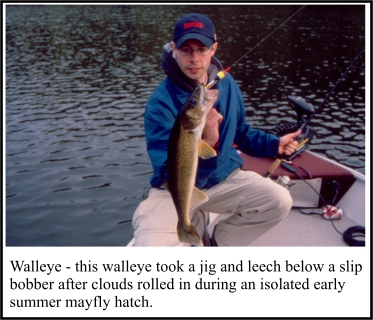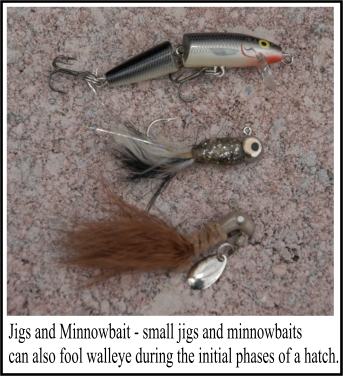Catching
Walleye during a Summer Mayfly Hatch In an earlier article, I discussed how walleye can aggressively feed on mayfly nymphs as they're recovering from the stresses of spawning and the winter. Although, walleye binge-feeding tapers come summer, they still target nymphs when available. Catching walleye during summer mayfly hatches can be more difficult than in spring, but can still be accomplished. I Anglers also need to move to where hatches happen. Jeff Evans, of Ontario Angling Services ( www.ontarioangling.com ), regularly targets walleye during small to average hatches. "During the mayfly hatch, I find that walleyes are generally up shallower. I have caught walleye in water as shallow as three feet, even on sunny days." When choosing where to fish flats, Evans concentrates on breaks and holes. "Walleye always like to have deeper water adjacent to their feeding flats," he explains.
When walleye are aggressively feeding on nymphs during a hatch in weedy areas, Evans' go-to bait is a bucktail jig in black, with either a red or white strip on the side. In the weedy flats he fishes, Evans aggressively jigs these baits. "This causes the feathers and hair to expand and contract giving the bucktail a life like appearance," he notes. To fish hatches, Greg Klatt, of ProFISHn't Angling Services ( www.profishntanglingservices.com ), starts with small, jointed minnow baits, fished on a stop-and-go retrieve. "It's important to mimic the action of the larva in the water as it floats up from the bottom, so a slow up and down cadence of your presentation is key," he advises. If these baits do not produce, he'll switch over to jigs. "I also like to swim jigs and will often scale down to using two to three inch grubs with 1/8 and even 1/16oz heads," he says. He works these baits along weed edges and over weed tops, searching for where walleye are located in the water column during a hatch. Another productive bait to target walleye during a hatch is a weighted, single-hook spinner rig, featuring a small #3 Colorado or Indiana blade. Colorado and Indiana blades allow the lure to be retrieved slowly, matching a nymphs' speed, while producing vibration and flash. Widely used on Lake Erie during hatches, it is often called a mayfly rig. A more subtle variation of the mayfly rig (resembling a live-bait rig) is a No. 2 or 4 octopus hook tied below a sinker. Tip rigs with a small piece of worm, anywhere from an half to two inches in size. Dragging mayfly rigs along the bottom or slowly swimming them to the surface will imitate nymph activity. Other elements of the retrieve should include frequent pauses, stalls, and lifting the bait up again. Rigs can also be counted-down to target suspended walleye feeding on emerging nymphs. During summer walleye feed on vulnerable mayfly nymphs during hatches. Using small baits and imitating a nymph's erratic movements will take fish when traditional baits won't get a sniff. Integrate the above strategies into your repertoire, and you'll be turning mayfly hatches into opportunities for increased catches.
|


 n
the summer, the early stages of a mayfly hatch can produce good fishing as
walleye will feed aggressively, competing for the small number of nymphs.
However, when large hatches occur lakes can become overrun with food, and
walleye tend to become extremely selective feeders. During prolonged,
gargantuan hatches it is sometimes best to cut your losses and travel to
another lake void of hatch activity.
n
the summer, the early stages of a mayfly hatch can produce good fishing as
walleye will feed aggressively, competing for the small number of nymphs.
However, when large hatches occur lakes can become overrun with food, and
walleye tend to become extremely selective feeders. During prolonged,
gargantuan hatches it is sometimes best to cut your losses and travel to
another lake void of hatch activity.  Small
jigs can be productive if walleye are bottom-feeding on nymphs during
hatches. Bucktail or marabou jigs are particularly deadly, as feathers and
hair pulsate in the water. This can be the subtle movement that is needed
to trigger finicky walleye. Evans finds deadsticking a bucktail jig can be
effective for neutral or negative mood 'eyes. "What this does is give
inactive walleye a chance to come over and examine the bait - this may get
you a few more strikes on those really slow days," he says.
Small
jigs can be productive if walleye are bottom-feeding on nymphs during
hatches. Bucktail or marabou jigs are particularly deadly, as feathers and
hair pulsate in the water. This can be the subtle movement that is needed
to trigger finicky walleye. Evans finds deadsticking a bucktail jig can be
effective for neutral or negative mood 'eyes. "What this does is give
inactive walleye a chance to come over and examine the bait - this may get
you a few more strikes on those really slow days," he says.